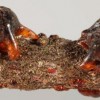Abstract
The Mexican lac scale is native to Mexico and Texas, but populations have been established in Florida. Adult female scales produce a high-domed ‘test’ or shell with four to six lobe-like projections that anchor the test to the plant surface. The test is hard and glossy with a reddish-orange tint around the edges, and darker toward the center. In some specimens, white string-like wax fiber extrusions project from the dorsum of the test, but these may break off. This 3-page fact sheet was written by Ian Stocks, and published by the UF Department of Entomology and Nematology, April 2013.
References
Brown SH. 2011. Tachardiella mexicana on wild tamarind. University of Florida, IFAS Lee County Extension Office. (10 September 2012.)
Chamberlin JC. 1923. A systematic monograph of the Tachardiinae or Lac Insects (Coccidae). Bulletin of Entomological Research 14: 147-212. https://doi.org/10.1017/S000748530005625X
Ferris G. 1955. Atlas of the scale insects of North America, v. 7, the families Aclerdidae, Asterolecaniidae, Conchaspididae, Dactylopiidae and Lacciferidae. iii. Stanford University Press, Palo Alto, California. 233 p.
Howard FW, Pemberton R, Hamon A, Hodges GS, Steinberg B, Mannion CM, McLean D, Wofford J. 2004. Lobate Lac Scale, Paratachardina lobata lobata (Chamberlin) (Hemiptera: Sternorrhyncha: Coccoidea: Kerriidae). University of Florida, IFAS, EDIS. (10 September 2012.)
Kondo T, Gullan PJ. 2011. Taxonomic review of the genus Tachardiella Cockerell (Hemiptera: Kerriidae), with a key to species of lac insects recorded from the New World. Neotropical Entomology 40: 345-367. https://doi.org/10.1590/S1519-566X2011000300009
Noyes JS. 2012. Universal Chalcidoidea Database. World Wide Web electronic publication. (10 September 2012.)
Triapitsyn S. 2008. A review of Tachardobius (Hymenoptera: Encyrtidae), with description of a new species from California, USA, a parasitoid of Tachardiella spp. (Hemiptera: Kerriidae). Zootaxa 1716: 44-52. https://doi.org/10.11646/zootaxa.1716.1.4
Unless otherwise specified, articles published in the EDIS journal after January 1, 2024 are licensed under a Creative Commons Attribution-NonCommercial-NoDerivs 4.0 International (CC BY-NC-ND 4.0) license.

